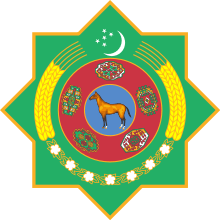Flag of Turkmenistan
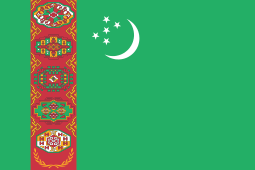 | |
| Name |
Turkmen: Türkmenistanyň baýdagy Түркменистаның байдагы |
|---|---|
| Use | National flag |
| Proportion | 2:3 |
| Adopted |
February 19, 1992 (Ratio 1:2) January 24, 2001 |
| Design | A green field with a vertical red stripe near the hoist side, containing five carpet guls stacked above two crossed olive branches; a white waxing crescent moon and five white five-pointed stars appear in the upper field, to the fly side of the red stripe |
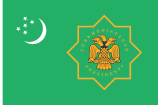 Variant flag of Turkmenistan | |
| Use | Presidential standard |
| Proportion | 2:3 |
| Adopted |
September 27, 1992 (Ratio 1:2) February 2007 |
The national flag of Turkmenistan (Turkmen: Türkmenistanyň baýdagy, Түркменистаның байдагы) features a white crescent (symbol of Islam) and five stars; those stars represent the five regions of the country. Placed upon a green field is a symbolic representation of the country's famous carpet industry. It was introduced as the flag of Turkmenistan on September 27, 1992 to replace the Soviet-era flag which consisted of a red background with two light blue bars in the middle. The modified version with a 2:3 ratio was adopted on January 24, 2001.
Description
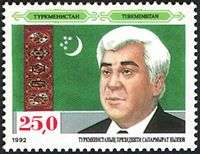
It features a green field with a vertical red stripe near the hoist side, containing five carpet guls (designs used in producing rugs) stacked above two crossed olive branches similar to those on the flag of the United Nations; a white waxing crescent moon, typical of Turkic and Islamic symbology, and five white five-pointed stars appear in the upper corner of the field just to the fly side of the red stripe.
The green and red colors appear in this flag because they have been venerated historically by the Turkmen. The waxing crescent moon symbolizes the hope of the country for a shining future and the stars represent the five provinces (welayatlar) of Turkmenistan – Ahal, Balkan, Dashoguz, Lebap, and Mary.
The five traditional carpet designs along the hoist represent the five major tribes or houses, and form motifs in the country's state emblem and flag. These Turkmen tribes in traditional order (as well as top to bottom) are Teke (Tekke), Yomut (Yomud), Saryk (Saryq), Chowdur (Choudur), and Arsary (Ersary). The middle design may also represent the Salyr (Salor), a tribe that declined as a result of military defeat before the modern period.
The wreath was added against the rules of heraldry, breaking up the carpet pattern. It was added as an afterthought to represent the "status of permanent neutrality", which was accepted by the United Nations General Assembly on December 12, 1995.
History
The flag of the Russian Empire was the official flag of Turkmenistan until the Russian Revolution.
Before the collapse of the Soviet Union in 1991, Turkmenistan had a flag similar to all other Soviet Republics; see Flag of the Turkmen SSR.
After independence in 1991, Turkmenistan adopted a flag very similar to the current design, on February 19, 1992. However, the designs on the left were different. In 1997, an olive branch was added to symbolise the peace-loving nature of the Turkmen people. The positioning of the crescent and stars was also changed, with the crescent positioned roughly to its current position but with the stars in a much more uneven position. In 2001 the flag changed from 1:2 to 2:3 and the green field was made lighter.[1]
.svg.png)
.svg.png)
Military flags
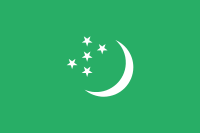
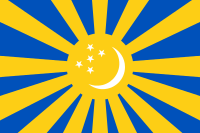
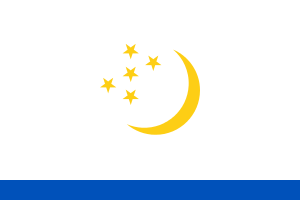
See also
References
External links
| Wikimedia Commons has media related to Flags of Turkmenistan. |
